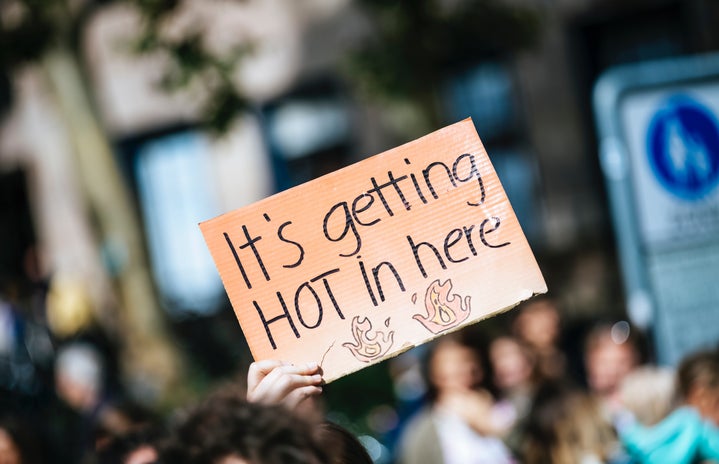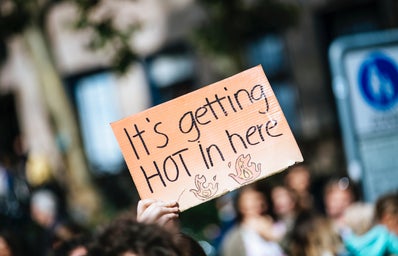The article below was written by Catarina Nestlehner and edited by Isabela Novelli Maciel. Liked this type of content? Check out Her Campus Cásper Líbero for more!
“The sirens are sounding. Our planet is talking to us and telling us something. And so are people everywhere. Climate action tops the list of people’s concerns, across countries, age, and gender. We must listen — and we must act — and we must choose wisely”
Antonio Guterres, secretary-general of the United Nations
After almost two years without in-person meetings because of COVID-19, the Conference of the Parties of 2021 was held in Glasgow, Scotland, from October 31 to November 13, when the outcome document was adopted to make efforts to bring climate change under control.
In this race against the clock, specialists and environmentalists have welcomed some topics of the agreement, however, others were considered not sufficient.
An overview
The COP (Conference of the Parties) is a climate summit that gathers annually the countries to reach an agreement on how to tackle climate change. This convention has been held since 1995, three years after the United Nations Framework Convention on Climate (UNFCCC) established as a world principle to prevent “dangerous” human interference on climate. The main goal of all COPs is to check the development and paths the countries are following while also making practical decisions and negotiations.
In 2021, the focus was to confirm — and increase — the objectives defined in the Paris Agreement of 2015, when the countries agreed to pursue efforts to limit global warming to 2.0 °C and to aim for 1.5 °C above pre-industrial levels. The goal is to keep cutting carbon emissions until they reach net-zero in 2050. All countries should have submitted new targets for reducing emissions ahead of COP26, but many have not come up with improved commitments and some major economies have no net-zero targets in place.
Recent studies show how critical is the decade in which we are: we have until 2030 to reduce emissions down to between 45 and 55%. If this does not come well, we practically lose the chance to make the net-zero goal happen until the end of the century. While some countries showed a decrease of 7% in carbon emissions, mainly because of the pandemic, Brazil, for example, showed an increase of 9%. Lately, the country has taken the opposite pathway that leads to the goal of reducing climate change.
But, what happens if the temperature overpasses 2.0 degrees?
The aim to keep the temperature under 1.5 °C draws a fine line for some countries to survive or not, according to the specialist in climate politics from Observatório do Clima, Stela Herschmann. We’re already experiencing a warmth of 1.1 °C above pre-industrial levels, and we have been able to see the devastation that it has already caused, including floods and extreme heat.
An IPCC report shows that the impacts will be severe even with 1.5 °C, and the scenario can get much worse when thinking about a 2.0 °C warmer planet. In this last dramatic hypothesis, the report finds it very likely to have at least one sea-ice-free summer every 10 years, which can lead to impacts to ocean circulation and have consequences for winter weather in the Northern Hemisphere. At 2.0 °C global warming, 79 million people could be exposed to flooding.
The risks can include the loss of species, transformation of terrestrial and ocean ecosystems, as well as food shortages, human health, and economic growth damages, according to the report. These impacts can be less catastrophic if the efforts to keep this precious half-degree lower to 1.5° succeed.
Based on The Climate Action Tracker (CAT), an independent scientific analysis that tracks government climate action, mainly in keeping the Paris Agreement target of holding warming well below 2.0°, none of the countries that have committed to the agreement are compatible with the aim of 1.5°. Just eight of them are almost sufficient, and the majority are highly insufficient.
“Of course the most developed countries, that most contributed to [avoid] climate change, must be the ones to do the great part of the actions. G20, for example, concentrates 80% of the gas emissions until now, so they should be responsible for 80% of the solutions for the problem. This is a balance we have to be aware of”, states the specialist in climate politics Stela Herschmann.
The Final Results Of COP26
COP26 concluded some important topics on the Paris Agreement article six, related to climate finance, and made some important negotiations and pacts. Because of this, it took a special place in history due to the alarming and urgent circumstances the planet has been put to, therefore the decisions made are decisive for humanity and nature.
After three drafts, the final document, known as the Glasgow Climate pact, firms up the global agreement to accelerate action on climate this decade. The most significant ambition is to increase goals on reduction of greenhouse gas emissions. The text emphasizes the need for developed countries to increase the money they give to those countries already suffering the effects of climate change, beyond the current 100 billion dollars target.
The USA and China Cooperation
The two biggest CO2 emitters made a surprising announcement, the so-called “joint statement”, at COP26, to boost climate cooperation over the next decade. According to Herschmann, it was much more of a political act than new objectives. They are seen as global rivals for many issues, but this was a huge step in the agreement, at least on climate matters. China’s top climate negotiator Xie Zhenhua told reporters that on climate change “there is more agreement between China and US than divergence”.
This announcement showed how the US returned to the climate agenda after Trump’s distressing period of distancing from agreements. “The realignment of the Americans to the climate decisions has great importance, due to this gap that Trump has made between Obama and Biden”, says Herschmann. Not only has Trump taken the US out of the Paris Agreement and been a climate negationist, but also made the China-US relationship very dull to convey. So, this mutual declaration had the main role of healing some wounds.
100 countries promised to stop deforestation by 2030
The pledge includes almost 14 billion euros (19.2 billion dollars) of public and private funds. These governments cover about 85% of the world’s forests. Although experts consider it a good move, many have warned about promising and not keeping. A similar promise was already committed in 2014, but it was never delivered. Not devastating the forests is an important topic on climate because the trees absorb vast amounts of the warming gas CO2.
“We have to stop the devastating loss of our forests,” stated the United Kingdom Prime Minister, Boris Johnson, “end the role of humanity as nature’s conqueror, and instead become nature’s custodian”.
The pledge to “halt and reverse deforestation and land degradation by 2030” encompasses promises to secure the rights of indigenous peoples, and recognize “their role as forest guardians”.
“Forests support communities, livelihoods, and food supply, and absorb the carbon we pump into the atmosphere. They are essential to our very survival,” Johnson said.
Brazil was one of the countries that promised to stop deforestation and yet hit the Amazon deforestation at the worst level in 15 years.
Methane
Some countries reached an agreement for reducing their overall emissions of methane. It is one of the most potent greenhouse gases, responsible for about 30% of global warming to date. Atmospheric concentrations of the gas have surged since 2007, sparking concern from scientists.
The Global Methane Pledge commits signatories to reduce methane by 30 percent by 2030, compared with 2020 levels. The initiative started with the US and the EU, but many others joined it. However, China, Russia, and India — some of the world’s top methane emitters — are not among them. The new initiative emphasizes making cuts by tackling methane leaking from oil and gas wells, pipelines, and other fossil fuel infrastructure.
Coal
More than 40 countries pledged to quit coal. Signatories to the agreement have committed to ending all investments in new coal power generation domestically and internationally. They have also agreed to phase out coal power in the 2030 decade for major economies, and 2040 for poorer nations, the UK said.
“Overall, this statement still falls well short of the ambition needed on fossil fuels in this critical decade”, declared Juan Pablo Osornio, head of Greenpeace delegation at COP26.
About three-quarters of the global warming seen today was caused by fossil fuel and around 40% of this damage has its source in coal, followed by petroleum (30%) and natural gas (20%). “This means that we must pursue efforts on stopping the usage of these sources”, says Stela Herschmann.
Almost at the end of the negotiations, India and China pressured for a significant change in the official text: instead of “eliminating” the usage of those kinds of sources, the text now promised to “accelerate the reduction” of that usage. This was the key, experts said, to weaken the Pact.
A study from the International Energy Agency (IEA) shows that to be compatible with the temperature of 1.5 °C global warming, any petroleum or coal project could be managed in the world from 2021 if the aim is to keep the Paris Agreement pledge. Which shows how insufficient the decisions were.
Boris Johson admitted some disappointment from the resolutions of this matter: “Those for whom climate change is already a matter of life and death, who can only stand by as their islands are submerged, their farmland turned to desert, their homes battered by storms, they demanded a high level of ambition from this summit”.
For the specialist from Observatório do Clima, Stela Herschmann “deforestation, methane, and coal pledges are possible, and the technology needed already exists. What we need is a compromise from politicians and serious public policies to see progress being made”.
What Now?
In the next COPs, losses and damages will become the most important topics as they are getting more and more recurrent, says the specialist. Another matter that she believes should be discussed is the finance matter, which, in her point of view, was a disaster at this year’s conference. For the future, she sees that the goal is more to implement the rules other than creating the rules themselves. Until the end of 2022, countries should bring to discussion more pledges to reach the 1.5 °C commitment.
According to the IPCC report, we are already living on a 1.1 °C warmer planet and, aiming for the most optimistic future, in the next 30 or 40 years we will not be compatible with the Paris Agreement goal. That means that the temperature will certainly reach a higher level than 1.5 °C (an event called ‘overshoot’) if there’s no change in mindset in the next few years. We will have to deal with the consequences of impacts that started to be traced some time ago, and even if we completely stopped emissions today, we wouldn’t be able to contain high impacts. So, reversing the damage is not possible.
Herschmann emphasizes that to reach a level of confidence in the compromises, they should have clearer pathways that can be followed. Only then, we can expect a less tragic life on earth.


